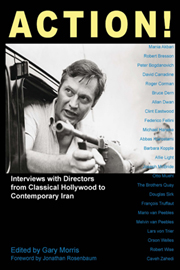Book contents
- Frontmatter
- Contents
- Foreword, by Jonathan Rosenbaum
- Editor's Preface
- Acknowledgements
- Introduction: The Art and Craft of Interviewing
- I Going Hollywood: Masters of Studio Style
- II Tickets to the Dark Side: Festival Favorites
- III Blows Against the Empire: Indie Godfathers
- 10 Sweet Soul Music: Melvin and Mario Van Peebles
- 11 Nearer My Corman to Thee: Roger Corman, Bruce Dern and David Carradine
- IV Edgeplay: Avant-Garde Auteurs
- V Women in Revolt: Artist-Activists
- VI The Canon: Brilliance without Borders
- Contributor Biographies
11 - Nearer My Corman to Thee: Roger Corman, Bruce Dern and David Carradine
from III - Blows Against the Empire: Indie Godfathers
Published online by Cambridge University Press: 05 March 2012
- Frontmatter
- Contents
- Foreword, by Jonathan Rosenbaum
- Editor's Preface
- Acknowledgements
- Introduction: The Art and Craft of Interviewing
- I Going Hollywood: Masters of Studio Style
- II Tickets to the Dark Side: Festival Favorites
- III Blows Against the Empire: Indie Godfathers
- 10 Sweet Soul Music: Melvin and Mario Van Peebles
- 11 Nearer My Corman to Thee: Roger Corman, Bruce Dern and David Carradine
- IV Edgeplay: Avant-Garde Auteurs
- V Women in Revolt: Artist-Activists
- VI The Canon: Brilliance without Borders
- Contributor Biographies
Summary
Roger Corman (born 1926), who turned 81 in April 2007, has assured his place in the history books several times over. A fast and furious director, he established the new land-speed record for no-budget feature filmmaking across the 1950s, outdoing even himself with 1960's Little Shop of Horrors (shooting schedule: two days). Meanwhile, as producer of almost 400 exploitation movies since 1955, he remains the most successful independent filmmaker Hollywood has ever known.
If he'd done nothing but direct the startling X: The Man with the X-Ray Eyes (1963) or his 1960s cycle of Edgar Allan Poe adaptations, films that found the perfect balance between doomy, haunted elegance and bright, trippy Pop hallucination, he would be remembered. But as that turbulent decade wore on, Corman uniquely divined and responded to currents in the air–and to the money burning holes in the pockets of a restless new youth audience–and started making films that reflected the times in ways major studios couldn't comprehend. Nihilistic biker flicks such as The Wild Angels (1966) and head movies like The Trip (1967) led directly to Easy Rider (1969) (which, of course, he was instrumental in getting made) and the subsequent revolution in '70s Hollywood.
His greatest legacy, however, might just be the incredible roster of directing and acting talent he has nurtured. From Jack Nicholson to Robert De Niro, Dennis Hopper to Martin Scorsese, almost all of the “Easy Riders, Raging Bulls” generation started out working for him in the 1960s.
- Type
- Chapter
- Information
- Action! , pp. 153 - 172Publisher: Anthem PressPrint publication year: 2009
- 1
- Cited by

